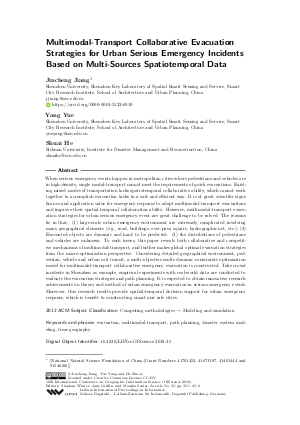Multimodal-Transport Collaborative Evacuation Strategies for Urban Serious Emergency Incidents Based on Multi-Sources Spatiotemporal Data (Short Paper)
Authors
Jincheng Jiang  ,
Yang Yue,
Shuai He
,
Yang Yue,
Shuai He
-
Part of:
Volume:
10th International Conference on Geographic Information Science (GIScience 2018)
Part of: Series: Leibniz International Proceedings in Informatics (LIPIcs)
Part of: Conference: International Conference on Geographic Information Science (GIScience) - License:
 Creative Commons Attribution 3.0 Unported license
Creative Commons Attribution 3.0 Unported license
- Publication Date: 2018-08-02
File

PDF
LIPIcs.GISCIENCE.2018.35.pdf
- Filesize: 432 kB
- 8 pages
Document Identifiers
Subject Classification
ACM Subject Classification
- Computing methodologies → Modeling and simulation
Keywords
- evacuation
- multimodal-transport
- path planning
- disaster system modeling
- time geography
Metrics
- Access Statistics
-
Total Accesses (updated on a weekly basis)
0Document
0Metadata
Abstract
When serious emergency events happen in metropolitan cities where pedestrians and vehicles are in high-density, single modal-transport cannot meet the requirements of quick evacuations. Existing mixed modes of transportation lacks spatiotemporal collaborative ability, which cannot work together to accomplish evacuation tasks in a safe and efficient way. It is of great scientific significance and application value for emergency response to adopt multimodal-transport evacuations and improve their spatial-temporal collaboration ability. However, multimodal-transport evacuation strategies for urban serious emergency event are great challenge to be solved. The reasons lie in that: (1) large-scale urban emergency environment are extremely complicated involving many geographical elements (e.g., road, buildings, over-pass, square, hydrographic net, etc.); (2) Evacuated objects are dynamic and hard to be predicted. (3) the distributions of pedestrians and vehicles are unknown. To such issues, this paper reveals both collaborative and competitive mechanisms of multimodal-transport, and further makes global optimal evacuation strategies from the macro-optimization perspective. Considering detailed geographical environment, pedestrian, vehicle and urban rail transit, a multi-objective multi-dynamic-constraints optimization model for multimodal-transport collaborative emergency evacuation is constructed. Take crowd incidents in Shenzhen as example, empirical experiments with real-world data are conducted to evaluate the evacuation strategies and path planning. It is expected to obtain innovative research achievements on theory and method of urban emergency evacuation in serious emergency events. Moreover, this research results provide spatial-temporal decision support for urban emergency response, which is benefit to constructing smart and safe cities.
Cite As Get BibTex
Jincheng Jiang, Yang Yue, and Shuai He. Multimodal-Transport Collaborative Evacuation Strategies for Urban Serious Emergency Incidents Based on Multi-Sources Spatiotemporal Data (Short Paper). In 10th International Conference on Geographic Information Science (GIScience 2018). Leibniz International Proceedings in Informatics (LIPIcs), Volume 114, pp. 35:1-35:8, Schloss Dagstuhl – Leibniz-Zentrum für Informatik (2018)
https://doi.org/10.4230/LIPIcs.GISCIENCE.2018.35
BibTex
@InProceedings{jiang_et_al:LIPIcs.GISCIENCE.2018.35,
author = {Jiang, Jincheng and Yue, Yang and He, Shuai},
title = {{Multimodal-Transport Collaborative Evacuation Strategies for Urban Serious Emergency Incidents Based on Multi-Sources Spatiotemporal Data}},
booktitle = {10th International Conference on Geographic Information Science (GIScience 2018)},
pages = {35:1--35:8},
series = {Leibniz International Proceedings in Informatics (LIPIcs)},
ISBN = {978-3-95977-083-5},
ISSN = {1868-8969},
year = {2018},
volume = {114},
editor = {Winter, Stephan and Griffin, Amy and Sester, Monika},
publisher = {Schloss Dagstuhl -- Leibniz-Zentrum f{\"u}r Informatik},
address = {Dagstuhl, Germany},
URL = {https://drops.dagstuhl.de/entities/document/10.4230/LIPIcs.GISCIENCE.2018.35},
URN = {urn:nbn:de:0030-drops-93630},
doi = {10.4230/LIPIcs.GISCIENCE.2018.35},
annote = {Keywords: evacuation, multimodal-transport, path planning, disaster system modeling, time geography}
}
Author Details
- Shenzhen University, Shenzhen Key Laboratory of Spatial Smart Sensing and Service, Smart City Research Institute, School of Architecture and Urban Planning, China
- Shenzhen University, Shenzhen Key Laboratory of Spatial Smart Sensing and Service, Smart City Research Institute, School of Architecture and Urban Planning, China
Funding
- Jiang, Jincheng: National Natural Science Foundation of China:[Grant Numbers 41701452, 41671387, 41401444 and 91546106]
References
-
S. I. Bingfeng, Ming Zhong, and G. A. O. Ziyou. Link resistance function of urban mixed traffic network. Journal of Transportation Systems Engineering and Information Technology, 8(1):68-73, 2008.

-
Z. Fang, X. Zong, Q. Li, Q. Li, and S. Xiong. Hierarchical multi-objective evacuation routing in stadium using ant colony optimization approach. Journal of Transport Geography, 19(3):443-451, 2011.

-
Michael Frank Goodchild. Data modeling for emergencies. The Geographical Dimensions of Terrorism, 2003.

-
Muhammad Moazzam Ishaque and Robert B. Noland. Trade-offs between vehicular and pedestrian traffic using micro-simulation methods. Transport Policy, 14(2):124-138, 2007.

-
Rui Jiang and Qing-Song Wu. Interaction between vehicle and pedestrians in a narrow channel. Physica A: Statistical Mechanics and its Applications, 368(1):239-246, 2006.

-
Q. Li, Z. Fang, Q. Li, and X. Zong. Multiobjective evacuation route assignment model based on genetic algorithm. In In Geoinformatics, 2010 18th International Conference on, pages 1-5, 2010.

-
W. Li, Y. Li, P. Yu, J. Gong, and S. Shen. The Trace Model: A model for simulation of the tracing process during evacuations in complex route environments. Journal of Transport Geography, 60:108-121, 2016.

-
P. Murray-Tuite and B. Wolshon. Evacuation transportation modeling: An overview of research, development, and practice. Transportation Research Part C: Emerging Technologies, 27:25-45, 2013.

-
S. Shekhar, K. S. Yang, and V. M. V Gunturi et al. Experiences with evacuation route planning algorithms. International Journal of Geographical Information Science, 26(12):2253-2265, 2012.

-
Xin Zhang and Gang len Chang. The multi-modal evacuation system (mes) for baltimore metropolitan region. In Intelligent Transportation Systems (ITSC), 2012 15th International IEEE Conference on. IEEE, 2012.

-
X. Zheng, T. Zhong, , and M. Liu. Modeling crowd evacuation of a building based on seven methodological approaches. Building and Environment, 44(3):437-445, 2009.

